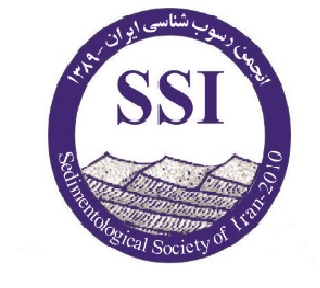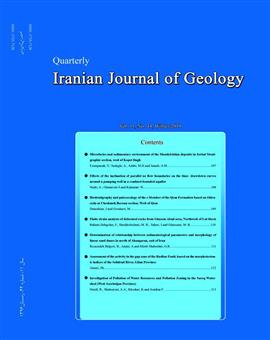Investigation of Pollution of Water Resources and Pollution Zoning in the Saroq Watershed (West Azerbaijan Province)
Subject Areas :1 , Shahsavari 2 , Gholam Abbas Fanaei Kheirabad 3 , فرهاد اسدیان 4
1 -
2 -
3 -
4 -
Keywords: Arsenic Zoning Geogenic Anthropogenic Saroq.,
Abstract :
Arsenic is a toxic element with environmental and health risks. The aim of this study is to investigate and monitor arsenic concentration level of pollution and its concentration zoning in the water resources of Saroq watershed. In this study, 45 samples from wells, springs and river were collected in two stages (filtered samples in the first step and bulk samples in the second step). The position of sampling points was determined based on expert judgment and random method. Anions were analyzed by gas chromatography and metals were analyzed by ICP-MS. The overall results indicated that water was polluted by arsenic in some areas. Evaluation of the origin and zoning maps of arsenic in water revealed that the source of pollution is both anthropogenic and geogenic resources. Most of the geogenic sources are located in the north-east and east of the area on the alteration zones and is resulted from Quaternary volcanic rocks forming source of the hot springs in the study area. Mining activities are the most important cause of pollution in the downstream area of the mines in the north of area, thus, it can be said that anthropogenic origin is a major cause of pollution. Transfering and re-deposition of arsenic in the study area is controlled by the solution- deposition and absorb- disposal reactions, which is controlled by Eh and pH. Transporting and re-deposition of arsenic is done by oxy-hydroxides of this element. In general, except for the northern and north-western parts, in most parts of the studied area, the level of pollution is not that much high so by considering appropriate management there will not be much pollution problem in the area.
رحیم سوری، ی.، 1390. اثرات زیستمحیطی معدن طلای آغ دره. پایاننامه دکتری، دانشگاه خوارزمی.
کریمی. م،1372. مطالعه سنگشناسی، کانیشناسی و نحوه تشکیل کانسار طلا و آرسنیک زرشوران تکاب. پایاننامه کارشناسی ارشد زمینشناسی اقتصادی، دانشگاه تربیتمعلم تهران.
مهندسین مشاور فرسپند آب، 1388. به هنگام سازی بیلان محدوده های مطالعاتی حوضه آبریز دریاچه ارومیه.
Ameh, E. G. and Akpah, F. A., 2011. Heavy metal pollution indexing and multivariate statistical evaluation of hydrogeochemistry of River PovPov in Itakpe Iron-Ore mining area, Kogi State, Nigeria. Advances in Applied Science Research. 2(1), 33-46.
Backman, B., Bodis, D., Lahermo, P., Rapant, S. and Tarvainen, T., 1997. Application of a groundwater contamination index in Finland and Slovakia. Environmental Geology, 36, 55–64.
Ben Issa, N., Rajakovic-Ognjanovic, V.N., Marinkovic, A.D., Rajakovic, L.V., 2011. Separation and determination of arsenic species in water by selective exchange and hybrid resins. 706 (1), 191-198.
Casiot, C., Ujevic, M., Munoz, M., Seidel, J. L. and Elbaz-Poulichet, F., 2007. Antimony and arsenic mobility in a creek draining an antimony mine abandoned 85 years ago (upper Orb basin, France). Applied Geochemistry, 22,788-798.
Nordstrom, D.K., 2002. Worldwide occurrences of arsenic in ground water. Science, 296 , 2143–2145.
Edet, A.E. and Offiong, O.E., 2002. Evaluation of water quality pollution indices for heavy metal contamination monitoring. A study case from Akpabuyo–Odukpani area, Lower Cross River Basin (southeastern Nigeria). GeoJournal, 57, 295–304.
Ficklin, W. H., Plumee, G. S., Smith, K. S. and McHugh, J. B., 1992. Geochemical classification of mine drainages and natural drainages in mineralized areas. In: Kharaka YK, Maest AS, (eds.), Water-rock interaction. Balkema, Rotterdam, 7, 381-384.
Matschullat, J., 2000. Arsenic in the geosphere—a review. Science of The Total Environment, 249(1-3), 297-312.
Krauskopf, K. and Bird, D., 1995. Introduction to Geochemistry. 3rd ed. McGraw Hill.
Larios, R., Fernandez-Martinez, R., LeHecho, I. and Rucandio, I., 2012. A methodological approach to evaluate arsenic speciation and bioaccumulation in different plant species from two highly polluted mining areas. Science of The Total Environment, 414, 600-607.
Modabberi, S., 2004. Enviromental geochemistry and trace element anomaly in the Takab area, and their impact on the Zarrineh roud reservoir dam, with special reference to Zarshuran deposit. Ph.D thesis (Unpublished), Shiraz University-Iran, 200
Mohan, S. V., Nithila, P. and Reddy, S. J., 1996. Estimation of heavy metal in drinking water and development of heavy metal pollution index. Journal of Environmental Science and Health Part A, 31, 283–289.
Morales, K.H., Ryan, L., Kuo, T.L., Wu, M.M. and Chen, C.J., 2000. Risk of internal cancers from arsenic in drinking water. Environmental Health Perspectives, 108, 655–661.
National Research Council, 1977. Arsenic: Medical and Biological Effects of Environmental Pollutants, National Academy of Sciences, Washington, DC.
Prasanna, M. V., Praveena, S. M., Chidambaram, S., Nagarajan, R. and Elayaraja, A., 2012. Evaluation of water quality pollution indices for heavy metal contamination monitoring: a case study from Curtin Lake, Miri City, East Malaysia. Environmental Earth Sciences, 67, 1987–2001.
Prasad, B. and Bose, J. M., 2001. Evaluation of the heavy metal pollution index for surface and spring water near a limestone mining area of the lower Himalayas. Environmental Geology, 41, 183–188.
Ayres, R.U. and Ayres, L.W., 1999. Accounting for Resources 2: The Life Cycles of Materials. Edward Elgar Publishing Inc., Cheltenham, UK.
Rahman, M., 2002. Arsenic and contamination of drinking-water in Bangladesh: a public-health perspective. Journal of Health Population Nutrition, 20, 193–197.
Rudnick, R.L. and Gao, S., 2014. Composition of the Continental crust. In: Rudnick, R.L. (Ed.), the Crust, v. 4. Elsevier, Amsterdam, pp. 1e51. Treatise of Geochemistry, H.D. Holland and K.K. Turekian (eds.).
Smedley, P. L. and Kinniburgh, D. G., 2002. A review of the source, behavior and distribution of arsenic in natural waters. Appl. Geochem., 17, 517-568.
Stocklin J., 1968. Structural history and tectonics of Iran: a review. American Association of Petroleum Geologists, 52, 1229-125.
U.S. Environmental Protection Agency, 2006. Drinking Water Standards and Health Advisories. EPA 822-R-06-013, Washington, DC.
Ungureanu, G., Santos, S., Boaventura, R. and Botelho, C., 2015. Arsenic and antimony in water and wastewater: Overview of removal techniques with special reference to latest advances in adsorption. Journal of Environmental Management, 151, 326-342.
WHO, 2011. Guidelines for Drinking-water Quality, fourth edItion, Geneva.
WHO, 2008. Guidelines for Drinking-water Quality. Third edition, Addenda.
Yaghubpur, A. and Karimi, M., 1998. Gold and Arsenic mineralization associated with sedimentary rocks of Zarshuran mine, north of Takab, Iran. Paper presented at the international congress of the Geolegical Society of Greece, 87-94.
Yan, X-P., Kerrich, R., and Hendry, M.J., 2000. Distribution of arsenic (III), arsenic (V) and total inorganic arsenic in pore waters from a thick till and clay-rich aquitard sequential, Saskatchewan, Canada. Geochim. Cosmochim Acta, 62(15), 2637-2648.
www.irimo.ir

